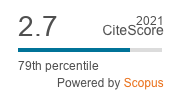An information analysis of a novel fractional chaotic systems and its application to image encryption
Keywords:
Approximate entropy; Chaotic behaviour; Lyapunov exponents; Image encryptionAbstract
This paper introduces a new class of fractional chaotic systems with no fixed points, corresponding to standard chaotic maps, which exhibit chaotic behavior. We show the relationships between entropy in information theory and intrinsic properties in chaos theory of the proposed system. The chaotic behavior of this class is analyzed by exploring numerically using phase plots, bifurcation diagrams, Lyapunov exponents, and approximate entropy to examine the dynamics of the designed system and assess the effectiveness of varying the fractional order. An exact expression for solutions of the system is determined. Additionally, a new chaotic attractor is presented. In the practical aspect of this work, we present an image encryption algorithm based on the proposed system. Based on the experimental results obtained, we can conclude that the proposed algorithm achieves effective encryption with enhanced security, making it resistant to common attacks.
References
J. D. Markel and A. H. J. Gray, Linear prediction of speech, vol. 12. Springer Science & Business Media, 2013.
L. R. Rabiner and R. W. Schafer, Programs for supporting the teaching of digital speech processing, in 2013 IEEE Digital Signal Processing and Signal Processing Education Meeting (DSP/SPE), IEEE, 2013, pp. 290–295.
J.-H. He, A review on some new recently developed nonlinear analytical techniques, International Journal of Nonlinear Sciences and Numerical Simulation, vol. 1, no. 1, pp. 51–70, 2000.
S. H. Abid and U. J. Quaez,‘Capacity of control for stochastic dynamical systems perturbed by mixed fractional brownian motion with delay in control, International Journal of Innovative Computing, Information and Control, vol. 15, no.5, pp. 1913–1934, 2019, doi: 10.24507/ijicic.15.05.1913.
M. Henon, A two-dimensonal mapping with a strange attractor, Communications in Mathematical Physics, vol. 50, pp. 376–392, 1976.
R. Lozi, Un attracteur étrange (?) du type attracteur de Hénon, Le Journal de Physique Colloques, vol. 39, no. C5, pp.C5-9, 1978.
D. L. Hitzl and F. Zele,An exploration of the Hénon quadratic map, Physica D: Nonlinear Phenomena, vol. 14, no. 3, pp. 305–326, 1985.
G. Baier and S. Sahle, “Design of hyperchaotic flows,” Physical Review E, vol. 51, no. 4, p. R2712, 1995.
K. Stefański, “Modelling chaos and hyperchaos with 3-D maps,” Chaos, Solitons & Fractals, vol. 9, no. 1-2, pp. 83–93,
M. Itoh, T. Yang, and L. O. Chua, Conditions for impulsive synchronization of chaotic and hyperchaotic systems, International Journal of Bifurcation and Chaos, vol. 11, no. 02, pp. 551–560, 2001
H. Zhang, D. Liu, and Z. Wang, Controlling chaos: suppression, synchronization and chaotification. Springer Science & Business Media, 2009.
A. Ouannas, X. Wang, A.-A. Khennaoui, S. Bendoukha, V.-T. Pham, and F. E. Alsaadi, Fractional form of a chaotic map without fixed points: Chaos, entropy and control,” Entropy, vol. 20, no. 10, p. 720, 2018.
A.-A. Khennaoui, A. Ouannas, S. Bendoukha, X. Wang, and V.-T. Pham, On chaos in the fractional-order discrete-time unified system and its control synchronization, Entropy, vol. 20, no. 7, p. 530, 2018.
A. K. Bagheedh, S. H. Abid, and S. A. Mehdi, Design a Fractional Chaotic Logistic Dynamical System, in Journal of Physics: Conference Series, IOP Publishing, 2021, p. 12055.
J. Dambre, D. Verstraeten, B. Schrauwen, and S. Massar, Information processing capacity of dynamical systems, Scientific reports, vol. 2, no. 1, p. 514, 2012.
S. Tiomkin, D. Polani, and N. Tishby, Control capacity of partially observable dynamic systems in continuous time, arXiv preprint arXiv:1701.04984, 2017.
P. Gaspard and X.-J. Wang, Sporadicity: between periodic and chaotic dynamical behaviors, Proceedings of the National Academy of Sciences, vol. 85, no. 13, pp. 4591–4595, 1988.
G. Deco and B. Schurmann, Information flow and chaotic dynamics, in Proceedings of International Workshop on Neural Networks for Identification, Control, Robotics and Signal/Image Processing, IEEE, 1996, pp. 321–329.
S. M. Pincus, Approximate entropy as a measure of system complexity.,Proceedings of the national academy of sciences, vol. 88, no. 6, pp. 2297–2301, 1991.
S. Pincus, Approximate entropy (ApEn) as a complexity measure, Chaos: An Interdisciplinary Journal of Nonlinear Science, vol. 5, no. 1, pp. 110–117, 1995.
C. E. Shannon, A mathematical theory of communication, The Bell system technical journal, vol. 27, no. 3, pp. 379–423, 1948.
S. H. Abid and U. J. Quaez, Rényi entropy for mixture model of multivariate skew Laplace distributions, in Journal of Physics: Conference Series, IOP Publishing, 2020, p. 12037.
J. B. Pesin, Ljapunov characteristic exponents and ergodic properties of smooth dynamical systems with an invariant measure, in Hamiltonian Dynamical Systems, CRC Press, 2020, pp. 512–515.
M. Mondal, F. Rahaman, and K. Singh, “Lyapunov exponent, ISCO and Kolmogorov–Senai entropy for Kerr–Kiselev black hole,” The European Physical Journal C, vol. 81, no. 1, pp. 1–16, 2021.
H. S. Kwok and W. K. S. Tang, A fast image encryption system based on chaotic maps with finite precision representation, Chaos, solitons & fractals, vol. 32, no. 4, pp. 1518–1529, 2007.
U. J. Quaez , Dynamics and Entropy Analysis of a Novel Fractional Chaotic System For Color Medical Image Encryption, International Journal of Innovative Computing, Information and Control (IJICIC), vol. 21, no. 4, pp. 919–935, 2025.
Downloads
Published
How to Cite
Issue
Section
License
Copyright (c) 2025 Results in Nonlinear Analysis

This work is licensed under a Creative Commons Attribution 4.0 International License.



